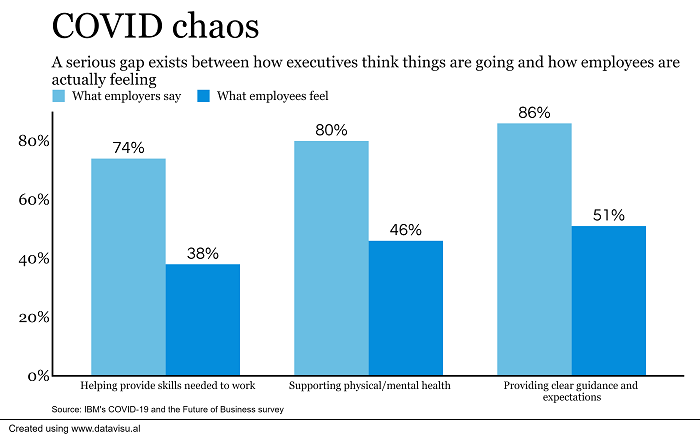
According to recent survey findings from IBM, employees feel tired and overloaded. At the same time, leaders are overwhelmingly focused on managing the internal challenges of their own organizations: employee safety, remote work access and more.
The COVID-19 and the Future of Business survey of 3,800 C-suite executives and employees in 20 countries from more than 22 industries, conducted by IBM’s Institute for Business Value (IBV), found that, while workforce safety, skills and flexibility are important to employers, employee satisfaction has been deprioritized.
The result? A serious gap exists between how executives think things are going and how employees are actually feeling.
Some key findings:
- 74% of executives believe they have been helping their employees learn the skills needed to work in today’s “new way,” while just 38% of employees agree.
- 80% of employers said they are supporting the physical and emotional health of their workforce, while only 46% of employees feel that support.
- 86% of executives agreed that their company provided clear guidelines and expectations for how their organization will work during this time, while just 51% of U.S. employees agreed.
- 67% of employers agreed that their company delivered clear communication on how their employees would be impacted during the COVID-19 crisis, yet half of U.S.-based employees disagreed.
According to Mark Foster, senior vice president of IBM Services, employee innovation and engagement in a time of extreme disruption can mean the difference between surviving and thriving. Employee engagement has a direct impact on customer experience as well.
“Leaders surveyed name inadequate skills and employee burnout as the biggest barriers to progress, but our study finds significant disconnect in how executives and employees rate businesses in addressing these gaps,” Foster says, adding that the survey also revealed that nearly six in 10 responding organizations have accelerated their digital transformations due to the pandemic.
Foster says IBM’s research found that traditional and perceived barriers like technology immaturity and employee opposition to change have fallen away, with 66% of executives surveyed saying they have completed initiatives that previously encountered resistance. The good news is the executives surveyed plan to prioritize internal and operational capabilities such as workforce skills and flexibility, critical areas to jumpstart progress.
“For many, the pandemic has knocked down previous barriers to digital transformation, and leaders are increasingly relying on technology for mission-critical aspects of their enterprise operations,” Foster says.
The study reveals three critical steps that emerging leaders surveyed are taking to survive and thrive:
- Improving operational scalability and flexibility. The ongoing disruption of the pandemic has shown how important it can be for businesses to be built for change. Many executives are facing demand fluctuations, new challenges to support employees working remotely and requirements to cut costs. Executing these new strategies may require a more scalable and flexible IT infrastructure.
- Applying AI, automation and other exponential technologies to help make workflows more intelligent. COVID-19 has disrupted critical workflows and processes at the heart of many organizations’ core operations. Such technologies as AI, automation and cybersecurity that could help make workflows more intelligent, responsive and secure are increasing in priority across the board for responding global executives. As executives increasingly invest in cloud, AI, automation and other exponential technologies, IBM recommends leaders keep in mind the users of that technology: their people.
- Leading, engaging and enabling the workforce in new ways. Ongoing IBV consumer research has shown that employees’ expectations of their employers have shifted amid the pandemic; they now expect that their employers will actively support their physical and emotional health as well as help them build the skills they need to work in new ways.
To address this gap, IBM recommends executives place a deeper focus on their people, putting employees’ end-to-end wellbeing first. Empathetic leaders who encourage personal accountability and support employees to work in self-directed squads that apply design thinking, agile principles, and DevOps tools and techniques can be beneficial.
“The pandemic has compelled employers to really rethink the tools in place and where they need to focus moving forward,” Foster says.
He says employers have had to face the challenge of finding new ways for entire workforces to do their job, meaning they have to remain focused on establishing new working models, changing policies and pushing through resistance to using certain tools because it’s necessary to thrive in today’s environment.
“As organizations have begun using these technologies, they’re setting a precedent for a new normal of work and how these tools become critical to success,” Foster says.
Also, expectations from workers are rising regarding work/life balance, health and the employer investments needed for them to do their work.
“At the end of the day, employers must remain focused on protecting the health of their employees, developing new communication strategies and building up the necessary skill sets that are most important to employees in this new world,” Foster says.